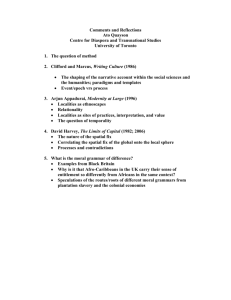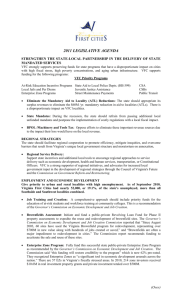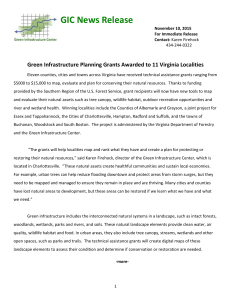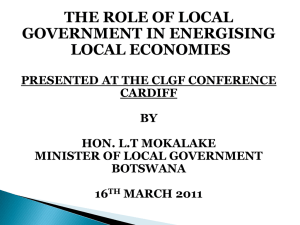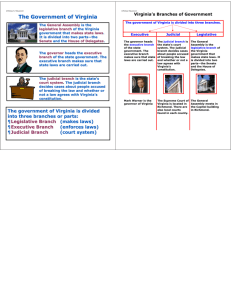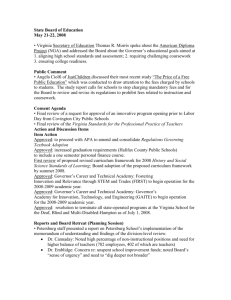POSC30206Roberts - James Madison University
advertisement
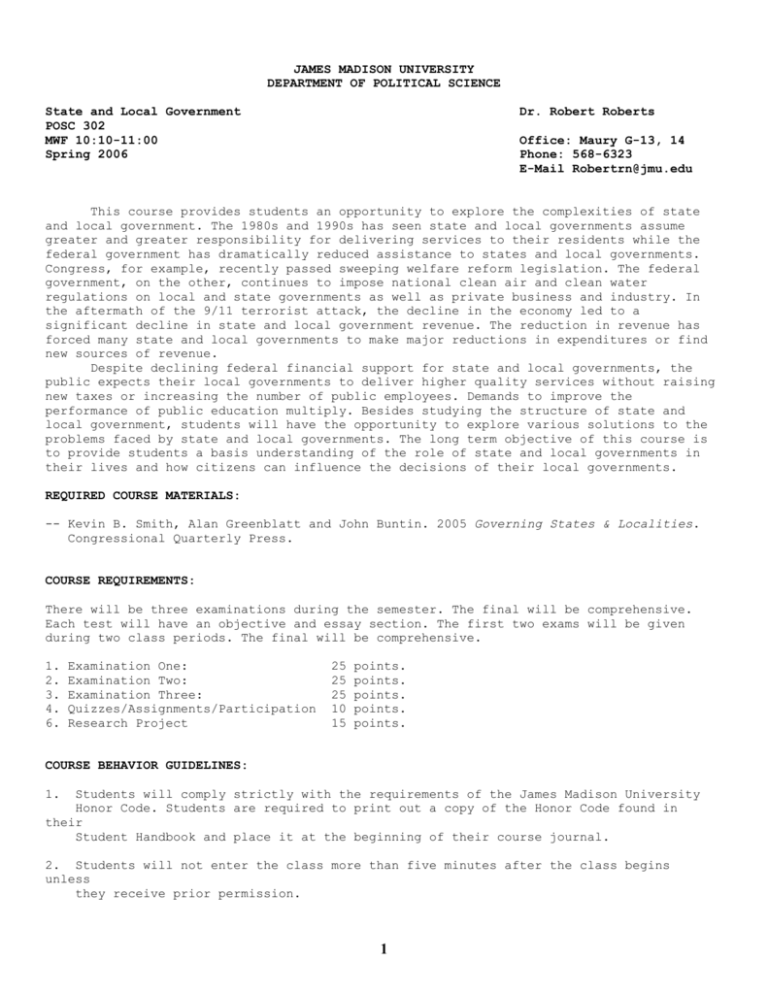
JAMES MADISON UNIVERSITY DEPARTMENT OF POLITICAL SCIENCE State and Local Government POSC 302 MWF 10:10-11:00 Spring 2006 Dr. Robert Roberts Office: Maury G-13, 14 Phone: 568-6323 E-Mail Robertrn@jmu.edu This course provides students an opportunity to explore the complexities of state and local government. The 1980s and 1990s has seen state and local governments assume greater and greater responsibility for delivering services to their residents while the federal government has dramatically reduced assistance to states and local governments. Congress, for example, recently passed sweeping welfare reform legislation. The federal government, on the other, continues to impose national clean air and clean water regulations on local and state governments as well as private business and industry. In the aftermath of the 9/11 terrorist attack, the decline in the economy led to a significant decline in state and local government revenue. The reduction in revenue has forced many state and local governments to make major reductions in expenditures or find new sources of revenue. Despite declining federal financial support for state and local governments, the public expects their local governments to deliver higher quality services without raising new taxes or increasing the number of public employees. Demands to improve the performance of public education multiply. Besides studying the structure of state and local government, students will have the opportunity to explore various solutions to the problems faced by state and local governments. The long term objective of this course is to provide students a basis understanding of the role of state and local governments in their lives and how citizens can influence the decisions of their local governments. REQUIRED COURSE MATERIALS: -- Kevin B. Smith, Alan Greenblatt and John Buntin. 2005 Governing States & Localities. Congressional Quarterly Press. COURSE REQUIREMENTS: There will be three examinations during the semester. The final will be comprehensive. Each test will have an objective and essay section. The first two exams will be given during two class periods. The final will be comprehensive. 1. 2. 3. 4. 6. Examination One: Examination Two: Examination Three: Quizzes/Assignments/Participation Research Project 25 25 25 10 15 points. points. points. points. points. COURSE BEHAVIOR GUIDELINES: 1. Students will comply strictly with the requirements of the James Madison University Honor Code. Students are required to print out a copy of the Honor Code found in their Student Handbook and place it at the beginning of their course journal. 2. Students will not enter the class more than five minutes after the class begins unless they receive prior permission. 1 3. Students will not eat or drink anything during the class. THIS RULE WILL BE STRICTLY ENFORCED. 4. Students will not leave the class until the class is over unless the student receives permission prior to the beginning of the class. 5. Students will take examinations and quizzes on assigned dates unless a legitimate emergency requires the absence of the students. PLEASE DO NOT CALL ME THE NIGHT BEFORE THE EXAMINATION ASKING TO RESCHEDULE THE EXAM. 6. Students will complete all assignments by the date assigned. A number of assignments require the use of computer with access to the World Wide Web and connected to a printer. Extensions will not be granted for the research project. 7. All written assignments will be done on a word processor. Please use 10pt type. Margins on all written assignments should be one inch at the top and the bottom. 8. Research project: Students will be required to complete a substantial research project. The project will be completed in phases. Each phase must be completed by the assigned date. Failure to complete any phase of the project by the assigned date will result in a one grade reduction on the final project. 9. Student are expected to attend all classes. However, I do not take class attendance. Consequently, students are expected to be in class to receive class handouts and to take announced or unannounced classes. 10. All work completed for the course must be backed up. Maintain a master file on a hard drive and back up work on a floppy disk or Zip disk. FINAL EXAMINATION: Monday May 1, 10:30 A.M. to 12:30 A.M. RESEARCH PAPER: State Government Analysis Paper. 1. 2. 3. 4. 5. 6. Word Processed: 12 point font Reference Page Bibliography: Please identify where you obtained each source. Library, Online, etc. Endnotes, In-text citation. Students are not permitted to submit a paper previously used for academic credit for this course. Students must list the names of individuals who have peer-reviewed the paper. 7. GRADING: A. B. C. D. F. 90-100 80-89 70-79 60-69 60 or below I do not use plus or minus grades in this course. I. THE POLITICAL FOUNDATIONS OF STATE AND LOCAL GOVERNMENT SESSIONS ONE AND TWO: JANUARY 09 AND 11: INTRODUCTION TO STATE AND COMMUNITY POLITICS: 2 Required Reading: – Governing States and Localities: Chapter One. 2-23. Chapter Four, 93-104. – Census of Governments” http://www.census.gov/govs/www/cog.2002.html Quiz One: Federalism Supreme Court Cases: Due Date: Wednesday January 18: Please prepare one paragraph abstracts for each of the following Supreme Court cases. Each case deals with an important federalism issue. Please use the Oyez format to prepare each of the briefs. 1. 2. 3. 4. 5. 6. 7. 8. 9. 10. 11. 12. 13. 14. 15. 16. 17. National League of Cities v. Usery (1976) Grove City College v. Bell (1984) Garcia v. San Antonio Metro-Transit Authority (1985) South Dakota v. Dole (1987) New York v. United States (1992) United States v. Lopez (1995) Seminole Tribe v. Florida (1996) Printz v. United States (1997) Alden v. Maine (June 23, 1999) Reno v. Condon, (January 12,2000) United States v. Morrison (May 15, 2000) Alden v. Maine (2000) Bush v. Gore (2000) Alabama v. Garrett (2001) Lorillard Tobacco Co. v. Reilly (2001) Nevada Department of Human Resources v. Hibbs (2003) Tennessee v. Lane (2004) Discussion Questions: 1. What are the major services funded by federal government revenue and delivered by federal government organizations? 2. What are the major services funded by federal and state government revenue and delivered by state government organizations? 3. What are the major services funded by local government revenue? 4. How many state and local governments are their in the United States? What are the different types of local governments? What is unique about the structure of local governments in the Commonwealth of Virginia? 5. What does the Constitution say about state governments? 6. What does the Constitution say about local governments? 7. What are the main fiscal responsibilities of state governments? 8. What are the main fiscal responsibilities of local governments? 9. What are the most important factors in determining whether a state is a good place to live? 10. What is meant by the phrase the “blossoming of state government?” 11. Why do the authors of the text argue that states have developed greater capacity to 3 deal with the problems their states face? 12. What are the most serious problems facing state and local governments today? 13. What impact does population growth and migration have on states and local communities? 14. How does the political culture of the state impact upon a state’s political system? 15. What type of political culture does the State of Virginia have? Terms to Know: Census of governments Devolution Individualistic political culture Interest groups Laboratories of democracy Moralistic political culture Political Culture Traditionalistic political culture SESSIONS THREE AND FOUR: JANUARY 13 AND JANUARY 18: THE EVOLUTION OF AMERICAN FEDERALISM Required Reading: –Governing States and Localities, Chapter Two: pp. 25-59. Discussion Questions: 1. What is the difference between state-centered federalism and nation-centered federalism? 2. What powers does the Constitution specifically delegate to the national government? What powers does the Constitution reserve to the states? 3. What role has the Supreme Court played in the evolution of nation-centered federalism? 4. What sections of the Constitution has provided the national government authority to regulate state affairs? 5. What impact has the Fourteenth Amendment on the management of state governments? 6. What methods has Congress used during the 20th century to expand their control over state and local governments? 7. Does the Constitution place limitations on the power of the national government to regulate state and local affairs? Term List: Bill of Rights Block Grants Categorical Grants (formula, project). Commerce Clause Concurrent powers Confederacy Cooperative Federalism Direct mandates 4 Dual Federalism Eleventh Amendment Enumerated powers Equal Protection Clause Exclusive powers Fourteenth Amendment Full Faith and Credit Clause General Revenue program General Welfare Clause Grants-in-aid Implied powers Indirect mandate National Supremacy Clause Necessary and Proper Clause New Federalism Nullification Power of the Purse Preemption Regulatory federalism Section 5 of the Fourteenth Amendment Selective Incorporation Doctrine Sovereign immunity Tenth Amendment SESSIONS FIVE AND SIX: JANUARY 20 AND 23: FISCAL AND REGULATORY FEDERALISM: THE ROLE OF DIRECT AND INDIRECT MANDATES: Required Readings: -– Governing States and Localities, Chapter 2,pp. 42-52. Discussion Questions: 1. What provisions of the Constitution give Congress the authority to regulate the conduct of state and local governments? 2. What are examples of mandates that Congress imposes upon state and local governments which require state and local governments to spend large amounts of local or state funds? 3. How has Congress used the Interstate Commerce Clause to impose mandates on state and local governments. 4. Discuss the role of the selective incorporation doctrine in increasing the authority of the federal courts to oversee the conduct of state and local governments. 5. What restrictions does the Equal Protection and Due Process clause of the Fourteenth Amendment place on the conduct of state and local government? 6. What is the difference between direct and indirect regulation of state and local government affairs by Congress? 7. How dependent are state and local governments on federal dollars to provide public goods and services? 8. What are the major methods Congress used to distribute funds to state and local governments? 5 9. What is the difference between categorical, block, formula and project grants? 10. What are the advantages and disadvantages of categorical, block, formula and project grants? 11. What is meant by the term regulatory federalism? 12. What is a federal rule? 13. What are the major types of federal mandates imposed upon state and local governments? 14. What types of federal mandates must the City of Harrisonburg comply with? 15. What impact does pre-emption have on state governments? 16. What is the difference between total and partial preemption? 17. What are the advantages and disadvantages of unfunded mandates? 18. In your opinion, what types of mandates should Congress impose upon local and state governments? SESSION SEVEN: JANUARY 25: THE SUPREME COURT: THE UMPIRE OF FEDERALISM: Required Readings: – Governing States and Localities, Chapter 2, pp. 52-57. – Cramton, Roger C. 1976. Judicial Law Making And Administration. Public Administration Review 36: 551-55. Retrieve JSTOR Case List: Brown v. Board of Education, 347 U.S. 483 (1954) Brown v. Board of Education, 349 U.S. 294 (1955) Swann v. Charlotte-Mecklenburg Board of Education (1971) San Antonio School District v. Rodriquez, 411 U.S. 1 (1973). Milliken v.Bradley, 418 U.S. 717 (1974). Missouri v. Jenkins, 515 U.S. 70 (1995). Discussion Questions. 1. What is meant by the term institutional reform litigation? 2. During the 1950s, 1960s, 1970s and 1980s, what types of public organizations most frequently found themselves subject to high levels of judicial oversight? SESSIONS EIGHT AND NINE: JANUARY 27 AND JANUARY 30th: ACCOUNTABILITY AND STATE CONSTITUTIONS: Required Reading: -- Governing States and Localities, Chapter 3: pp. 62-91. Discussion Questions: 6 1. Why did states enact such detailed state constitutions during the early 19th century? 2. What issues are typically covered by state constitutions? 3. Why did the first state constitutions place so much power in the hands of the legislative branch? 4. What are the most frequent criticisms of state constitutions? 5. What explains the tendency for states to enact long state constitutions? 6. What types of restrictions do state constitutions normally place on the taxing and borrowing authority of state and local governments? 7. What are the most serious management problems for state governments created by state constitutions? 8. What are the essential characteristics of the Model State Constitution? 9. What are the informal and formal ways to change state constitutions? Term List: Appropriations bills Ballot initiatives Bicameral legislatures Colonial Charters Constitutional Amendments Constitutional Convention Dedicated funds Dillon’s Rule Direct Democracy Dual Constitutionalism Electorate The Franchise Home Rule Jim Crow laws Line-item veto Model State Constitution Municipal Charter Natural law or higher law Ratification Reconstruction Referendum Super majority Unicameral Earmarked revenues State Bill of Rights SESSION TEN: FEBRUARY 1: CONSTITUTIONAL REFORM AND SOCIAL CHANGE: Required Reading: –- Governing States and Localities, Chapter 3, pp. 74-91. Discussion Questions: 1. What changes have taken place in the evolution of state constitutions as an instrument of social change over the last thirty years? 2. What role to state courts play in reforming state constitutions? 3. What are examples of state Bill of Rights provisions not found in the Federal Constitution? 4. What rights are commonly found in some state constitutions which are not found in the United States Constitution? 5. What changes in the Virginia Bill of Rights would you propose? 7 6. What is the relationship between state constitutions and the Federal Constitution? SESSIONS ELEVEN AND TWELVE: FEBRUARY 3 AND FEBRUARY 6TH: POLITICAL CULTURE, POLITICAL ATTITUDES AND PARTICIPATION. Required Reading: Governing States & Localities. Chapter Four, pp. 94-96, 104-129. Discussion Questions: 1. What level of government has the greatest responsibility for regulating elections at the state and local government level? 2. What changes did the Motor Voter law make in the way state and local governments conducted elections? 3. What eligibility requirements may state place on voting? 4. What are the different types of primaries used by states to regulate the selection of candidates by political parties? 5. Has the Supreme Court issued any important decisions regulating the conduct of state and local elections? 6. How much discretion does a state have in drawing the boundary lines for state and local election district? Why do state legislatures spend so much time on drawing boundary lines for election districts? 7. May the boundary lines for election district be drawn to increase the likelihood that a minority will win an election? Term List: Australian Ballot (Secret ballot) Ballot Access Board of Elections Direct Democracy Early Voting Election Administration Fifteenth Amendment Initiative Nineteenth Amendment Non partisan elections Non-voters Office Group Ballot Party Column Ballot Party Identification Party registration Political affiliation Progressive Movement Recall Referendum Straight Ticket Twenty-Fourth Amendment 8 Twenty-Sixth Amendment Voter Registration Act of 1993 (Motor Voter) Voter Turnout rates Voting Age Population (VAP) Voter Registration Requirements Voting Rights Act of 1965 SESSION THIRTEEN: FEBRUARY 8TH: POLITICAL CULTURE, REFORM AND VIRGINIA: Required Readings: --Online Source: Virginia State Board of Elections: http://www/sbe.state.va.us/ --“Political Ethics and Reform in Virginia: Marching to the Beat of a Different Drummer.” Government and Politics In Virginia. On Reserve Discussion Questions: 1. What are unique features of the political culture of Virginia? 2. What restrictions does Virginia place on political campaign contributions? 3. What percentage of Voting Age Virginians are registered to vote? 4. What percentage of registered voters cast ballots in presidential elections? 5. What percentage of registered voters cast ballots in the typical election for governor? 6. What explains the victory of Tim Kaine over Jerry Kilgore in the 2005 Governor’s race? 7. What explains the victories of Republican candidates for Lieutenant Governor and Attorney General in the 2005 Virginia elections? 8. What impact did new voters have on the 2005 Virginia elections? SESSION FOURTEEN: FEBRUARY 10: EXAM ONE: OBJECTIVE SECTION: SESSION FIFTEEN: FEBRUARY 13: EXAM ONE: ESSAY SECTION: SESSION SIXTEEN AND SEVENTEEN: FEBRUARY 15TH AND 17TH: POLITICAL PARTIES AND INTEREST GROUPS: Required Reading: –Governing States and Localities, Chapter Five, pp. 132-168. Discussion Questions: 1. What are the major characteristics of political parties? 2. What types of individuals are likely to join political parties? 3. What explains the failure of third parties to have a major impact upon state and local politics? 9 4. What are the major characteristics of modern political campaigns? 5. What impact does money have on political campaigns? 6. What efforts have states made towards campaign finance reform? 7. What methods do interest groups use to influence public policy? 8. What are the major ways that political parties select candidates to run for office? 9. What is a caucus? 10. What are the different types of primaries? 11. Do political parties favor closed or open primaries? 12. Do states place any restrictions on lobbying by lobbyists? 13. What are the most common forms of citizen participation in state or local government? 14. What individual characteristics help to distinguish between those who participate in government and those who do not? 15. What impact does low levels of public participation have on decision making in state and local governments? 16. What are some methods that might increase citizen participation with government? 17. Would government policies change if a large percentage of citizens participated in government? 18. What statutory methods have been used to increase citizen access to government? 19. What are the main characteristics of open meeting laws and freedom of information laws. 20. How do most citizens learn about what is taking place in their government? Term List Blanket primaries Candidate-centered politics Cause lobbyist Closed primaries Contract lobbyist Crossover voting Dealignment Independent expenditures Nonpartisan ballots Open primaries Party conventions Patronage Political action committee Political machines Political parties Primary elections Realignment Responsible party model Runoff primary Soft money Straight ticket Swing voters Ticket Splitting Voter identification II. THE INSTITUTIONS OF LOCAL AND STATE GOVERNMENT SESSIONS EIGHTEEN AND NINETEEN: FEBRUARY 20 AND FEBRUARY 22nd: THE INSTITUTIONS OF LOCAL 10 GOVERNMENT: Required Reading -- Governing States and Localities, Chapter 10, pp. 337-362. Discussion Questions: 1. What are the major types of local general purpose governments? 2. What are the major types of special purpose local governments? 3. What is the organizational structure of the different types of general purpose governments? 4. What arguments are most frequently made in support and against the strong major form of government? 5. What arguments are most frequently made in support and against the mayor/counsel form of government? 6. What arguments are most frequently made in support and against the country administrator form of government? 7. What states permit the election of county executives? 8. What states divide their counties into townships? 9. What are the most pressing problems facing large city governments across the country? 10. What explains the proliferation of special districts over the last four decades? 11. What are the different types of school districts? Term List: Annexation At-large elections Boards of commissioners Charter City council City manager City-county consolidation City manager system Commission system County executive Counties Dependent school district Dillon’s rule Edgeless cities General act charters Home rule Independent school district Living wage laws Mayor Mayor-council system Megalopolis Municipalities 11 Smart growth Special act charters Special districts Strong mayor Unincorporated territory Wards Ward, or district, elects Weak mayor SESSION TWENTY: FEBRUARY 24: RURAL, SUBURBAN AND URBAN AMERICA: THE GREAT DIVIDE: Required Readings: – To Be assigned: Discussion Questions: 1. What are the major theories of community power? 2. What is the major difference between the theories of Elitist and Pluralist Community Power? 3. What impact does the business community have on community power and politics? 4. What tools does business use to influence community policies? 5. What has the impact of Globalization been on municipal politics? 6. What are the major factors considered by corporations before they make a major investment in a community or state? 7. What incentives do municipalities, counties and states make use of to attract businesses? 8. What are the major problems facing mayors and the county administrators of urban counties? 9. What is meant by the Bipolar City or Bipolar County? 10. What are the major problems facing independent cities in Virginia? SESSIONS TWENTY-ONE AND TWENTY-TWO: FEBRUARY 27 AND MARCH 1 STATE LEGISLATURES: Required Reading: –Governing States and Localities , Chapter 6: pp. 171-211. Discussion Questions: 1. What are the major responsibilities of state legislatures? 2. What are the advantages and disadvantages of full or part-time legislators? 3. What are the most important ethics problems involving state legislators? 4. What is the organizational structure of most state legislatures? 12 5. What methods do state legislatures use to monitor the operation of state government agencies? 6. What are the steps necessary for a bill to become law? 7. What is the role of the committee and subcommittee in the legislative process? 8. What interest groups exercise the greatest influence on state legislators? 9. How long is the typical session of a state legislative? Term List: Apportionment Casework Caucus Coalition building Committee Compromise Constituents Constituent service Delegates Districts Filibusters Gerrymanders Incumbent Logrolling Majority-minority districts Majority rule Malapportionment Oversight Professionalism Rank-and-file Redistricting Representation Riders Trustees SESSION TWENTY-THREE: MARCH 3: LEGISLATIVE REFORM: Required Reading: – To Be Assigned. Discussion Questions: 1. What are the occupations of the majority of state legislators? 2. Do legislative ethics rules usually permit legislators to supplement their legislative income with outside work? 3. What are the most common types of restrictions placed upon the conduct of state legislators? 4. What are some proposals to increase the number of women and minorities in state legislatures. 5. What arguments can be made in support or against term limitations? 6. What changes to the organization of state legislatures are frequently proposed to to improve their effectiveness? Term List: 13 SESSIONS TWENTY-FOUR AND TWENTY-FIVE: MARCH 13 AND 15: GOVERNORS AND THE CHALLENGE OF EXECUTIVE LEADERSHIP: Required Reading: -- Governing States & Localities. Chapter 7: pp. 214-247. Discussion Questions: 1. How has the role of governor changed over the last century? 2. What are the main duties of the modern governor? 3. What tools does a governor have to management state government? 4. What are the formal powers of a governor? 5. What are the informal powers of a governor? 6. Has the Supreme Court placed any constitutional limitations on the patronage powers of governors? 7. How does a governor use the budget to set policy? 8. What are the most important informal powers used by a governor? 9. What qualities make a good governor? 10. What limits do states place on governors serving more than one term? Term List: SESSION TWENTY-SIX: MARCH 17: OTHER STATEWIDE OFFICES: Required Readings: – Governing States and Localities, Chapter 7. pp. 248-252. Discussion Questions: 1. Are there any unique characteristics of Virginia governors? 2. What were the major policy initiatives of the last ten Virginia governors? 3. Why does Virginia limit governors to one consecutive four year term? 4. What are the major arguments for and against permitting Virginia governors to serve to consecutive terms? 5. Have any Virginia governors served more than one term? Term List: 14 SESSIONS TWENTY-SEVEN AND TWENTY-EIGHT: MARCH 20 AND 22: COURTS: TURNING LAW INTO POLTICS: Required Reading: – Governing States & Localities, Chapter 8: pp. 256-298. Discussion Questions: 1. How many other executive branch officials are typically elected? 2. What are the main responsibilities of state agencies and commissions? 3. What are the different types of executive branch organizations? 4. What is the difference between a state department, agency, board and commission? 5. What are examples of state boards and commissions? 6. Who is responsible for appointing members of executive boards and commissions? 7. What are the advantages and disadvantages of electing executive branch officials? 8. What are the major criticisms of state bureaucracies? 9. Which types of state agencies employ the largest number of employees? 10. What steps are states taking to reinvent government? 11. Why have many states adopted privatization as a way to improve the efficiency of government? 12. What judicial functions do state agencies perform? 13. What judicial functions do state agencies perform? Terms List: SESSIONS TWENTY-NINE AND THIRTY: MARCH 24 AND MARCH 27: PROSECUTION AND DEFENSE OF CASES IN STATE COURTS: Required Reading: –GOVERNING STATES AND LOCALITIES, pp. 278-298. Discussion Questions: 1. What are responsibilities of the different levels of the judicial system? 2. What is the difference between a unified and non unified court system? 3. What methods do the legislative and judicial branches have of controlling the judicial branch? 4. What are the different methods used by states to select judges? What are the 15 advantages and disadvantages of the different ways to select judges? 5. Does the background of judges have any impact on their judicial decisions? 6. What are the most serious management problems facing state court systems? 7. What are the major criticisms of judicial systems? 8. What are the arguments in favor and against the new judicial activism? 9. What arguments are made for and against limiting the discretion of judges? 10. How much discretion should judges have to determine the sentences of individuals found guilty of criminal offenses? 11. What methods are states using to deal with growing caseloads? 12. What are the advantages and disadvantages of alternative dispute resolution as a way to reduce the burden on the courts? 13. What steps can states take to reduce the amount of litigation? 14. How are courts using technology to reduce delays? 15. How does alternative dispute resolution attempt to deal with the problems associated with state judicial systems? 16. How does alternative dispute resolution differ from traditional judicial systems? 17. How has the pattern of crime changed in the United States over the last forty years? 18. Are there any groups in American society with a higher likelihood of their members committing crimes? 19. Which level of government has primary responsibility for fighting crime? 20. What are the most serious problems facing law enforcement agencies in fighting crime? 21. What type of criminal offense has increased most rapidly over the last twenty years? 22. Who are the major actors in the establishment and implementation of criminal justice policy? 23. What role has the Supreme Court played in reforming the criminal justice system over the last thirty years? 24. What role do citizens have in fighting crime? 25. What is meant by the term victimless crime? 26. What is meant by the term indeterminate sentencing? 27. What is meant by the term determinate sentencing? 28. What is meant by the term creative sentencing? 16 29. What is a criminal diversion program? 30. What steps are states taking to increase the capacity of their jails and prisons? 31. What steps are states taking to decrease the number of individuals in jail or prison? Terms List: SESSION THIRTY ONE: MARCH 29: EXAM TWO: OBJECTIVE SECTION SESSION THIRTY-TWO: MARCH 31: EXAM TWO: ESSAY SECTION SESSIONS THIRTY THREE AND THIRTY-FOUR: APRIL 3 AND APRIL 5: BUREAUCRACY: Required Readings. – Governing, Chapter 9: pp. 302-330. Discussion Questions: Term List: SESSIONS THIRTY FOUR AND THIRTY FIVE: APRIL 7 AND APRIL 10: FINANCE: Required Readings: – Governing States & Localities, Chapter 11, pp. 366-384: Discussion Questions: 1. What are the most characteristics of state and local finance? 2. What is the difference between own source revenue and intergovernmental transfers? 3. How have state and local governments attempted to diversity their sources of revenue? 4. Why are some states high tax states and other states are low tax states? 5. How does federal tax laws help states and localities to raise their taxes? 6. What is meant by a state's tax capacity? 7. What is meant by a state's tax effort? 8. What are the major criteria for evaluating the use of different types of taxes? 9. What are the most important state taxes? What are the advantages and disadvantages of these different types of taxes? 10. What are the most important local taxes? What are the advantages and disadvantages of the different types of local government taxes? 17 11. Are there any other major sources of own source revenue besides taxes? 12. What factors have led to growing public resistance to tax increases despite the fact that Americans are not heavily taxed compared to residents of other countries? 13. What types of restrictions does state laws or constitutions typically place on the ability of state and local governments to raise money? 14. What methods have states and localities used to deal with tax revolts? 15. What are the most frequent cases of fiscal stress for states? 16. Why are large urban centers under much greater fiscal stress than suburban communities? 17. What methods do states use to estimate revenues and expenditures? 18. How does politics play a role in the estimation of state and local revenues? 19. What are the different types of borrowing used by state and local governments? 20. What is the difference between long and short-term borrowing? 21. How to states and localities use cash management practices to additional money? Have any jurisdictions run into problems caused by aggressive cash management practices? 22. How much financial assistance do states typically provide their local governments? 23. How is state aid used to deal with fiscal disparity among localities in a state? 24. What is the difference between a general obligation bond, revenue bond and industrial development bond? 25. Which taxes do economists consider progressive and regressive? Terms List: SESSION THIRTY-SIX AND THIRTY SEVEN: APRIL 12 AND APRIL 14: THE BUDGET PROCESS AND EXPENDITURES: Required Reading: – Governing States & Localities, Chapter 11: pp. 384-392. – Virginia Department of Planning and Budget http://www.dpb.state.va.us/budget/budget.htm Discussion Questions: 1. How is the financial structure of Virginia similar to or different from other states? 2. How is the financial structure of local governments similar to or different from local governments located in other states? 18 3. What are the major criticisms of the current system for financing Virginia state governments and local governments in Virginia? 4. How does the status of Virginia as a “home rule” state impact the financial options available to local governments? Terms List: III. POLICY ISSUES AND STATE AND LOCAL GOVERNMENT SESSIONS THIRTY-EIGHT AND THIRTY NINE: APRIL 17 AND APRIL 19: EDUCATION POLICY AND REFORM: Required Reading: – Harrigan and Nice, Chapter, 13, Poverty and Social Welfare Policy, pp. 335-368. – Burns, Chapter 9, Making State and Local Policy, Social Services, pp. 167-170. Discussion Questions: Terms List: SESSIONS FORTY AND FORTY-ONE: APRIL 21 AND APRIL 24: EDUCATION POLICY: Required Readings: –Governing States & Localities, Chapter 12, pp. 396-412. Discussion Questions: 1. Which level of government has primary responsibility for paying for elementary and secondary education? 2. What unit of government is primarily responsible for delivering K-12 education? 3. The vast majority of school systems are governed by . 4. Over the last forty years, the percentage of public school expenditures financed by state governments has . 5. The keystone of state educational policy making is the . 6. What are the major federal aid to education landmarks? 7. What are the major education reforms proposed by conservatives and liberals? 8. What is the most important factor in determining student achievement? 9. How have states tried to deal with disputes regarding unequal funding of schools? 10. Why has equalizing financial resources across school districts been so difficult? Term List: 19 SESSION FORTY-TW0: APRIL 26: EDUCATION REFORM: Required Readings: – Governing States & Localities, Chapter pp. 412-429. Discussion Questions: Terms List: SESSION FORTY-THREE: APRIL 28: HEALTH AND WELFARE: Required Readings: – Governing States & Localities, Chapter 14. pp. 466-495. Discussion Questions: 1. What are the most frequently discussed explanations for poverty? 2. What groups in American society are most likely to live below the federal poverty line? What groups in society are protected from poverty by the largest number of state and federal programs? 3. 4. When did the federal government begin to take over responsibility for dealing with poverty in American society? 5. What are the major federally funded anti-poverty programs? 6. What are the major poverty programs funded, in part, by the states? 7. What is the difference between medicaid and medicare? 8. Which states have the highest monthly AFDC payments? 9. What are the major direct cash transfer poverty programs? 10. What are the major in-kind poverty programs? 11. What are the major social insurance program which are not tied to the income of recipients? 12. What reforms have states adopted to improve the quality of life for children born into poverty? 13. Why has it proven difficult for states to force fathers to contribute to the cost of raising their children? 14. What changes in federal welfare laws did Congress recently make? 15. Does federal law limit the length of welfare payments? 20 16. What arguments can be made in support and against workfare? Term List: Aid to Families and Dependent Children (AFDC) Centers for Disease Control and Prevention (CDC) Managed Care Medicaid Medicare Social Safety Net Social Security Act State Children’s Health Insurance Program (CHIPS) Temporary Assistance for Needy Families (TANF) 21

